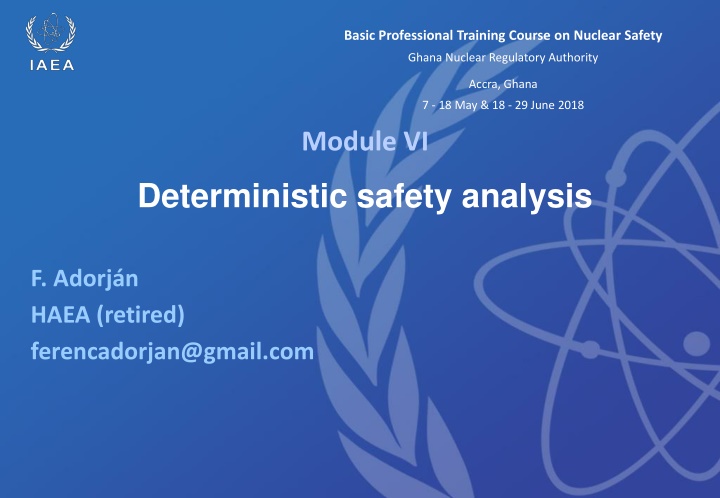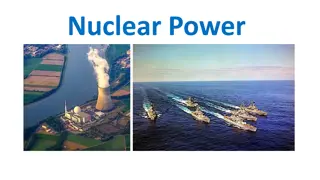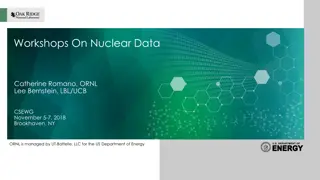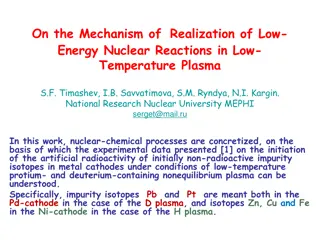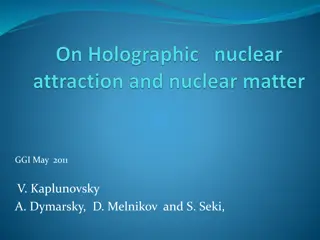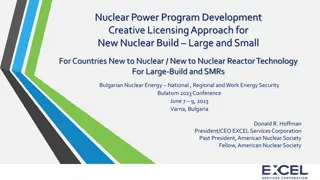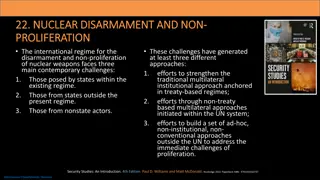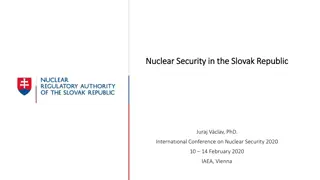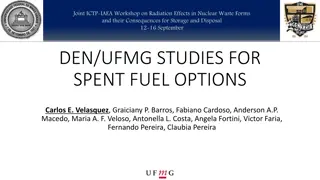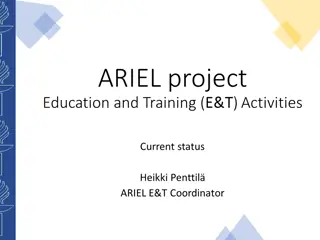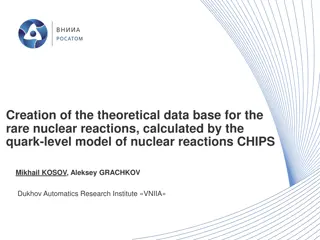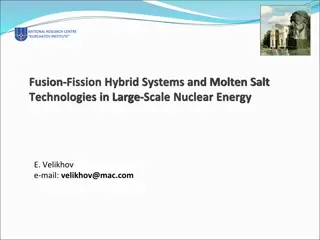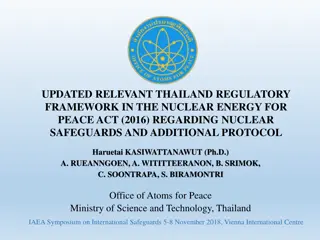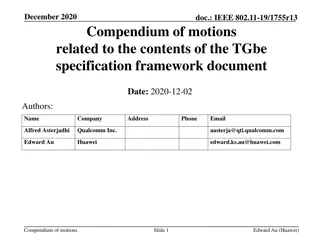Nuclear Safety Analysis Overview" (78 characters)
This course covers deterministic safety analysis in nuclear plants, focusing on safety assessments, plant states, initiating events, acceptance criteria, different analysis types, computer codes, verification, and applications. By the end of the training, participants will have a solid understanding of the methodology and significance of deterministic safety analyses. The course provides in-depth knowledge essential for ensuring nuclear safety and meeting regulatory requirements.
Download Presentation

Please find below an Image/Link to download the presentation.
The content on the website is provided AS IS for your information and personal use only. It may not be sold, licensed, or shared on other websites without obtaining consent from the author.If you encounter any issues during the download, it is possible that the publisher has removed the file from their server.
You are allowed to download the files provided on this website for personal or commercial use, subject to the condition that they are used lawfully. All files are the property of their respective owners.
The content on the website is provided AS IS for your information and personal use only. It may not be sold, licensed, or shared on other websites without obtaining consent from the author.
E N D
Presentation Transcript
Basic Professional Training Course on Nuclear Safety Ghana Nuclear Regulatory Authority Accra, Ghana 7 - 18 May & 18 - 29 June 2018 Module VI Deterministic safety analysis F. Adorj n HAEA (retired) ferencadorjan@gmail.com
Learning objectives After completing Module 6, the trainee will be: 1. able to understand the essence and the methodology of deterministic safety analyses. 2. able to understand the significance of plant states and the related safety analyses. 3. able to understand the concept of postulated initiating events and the methodology for selecting them. 4. able to understand the difference between conservative and best estimate approaches. 5. familiar with the different applications of deterministic analyses. Module 6 - DSA 7 - 18 May & 18 - 29 June 2018 2
Contents 1. Safety assessment deterministic safety analysis 2. Plant states 3. Initiating events postulated initiating event 4. Acceptance criteria 5. Types of deterministic safety analyses 6. Conservative deterministic safety analysis 7. Best estimate plus uncertainty analysis 8. Sensitivity and uncertainty analysis 9. Computer codes for deterministic safety analysis 10.Verification and validation of computer codes 11.Applications of deterministic safety analyses Module 6 - DSA 7 - 18 May & 18 - 29 June 2018 3
Basic Professional Training Course on Nuclear Safety Ghana Nuclear Regulatory Authority Accra, Ghana 7 - 18 May & 18 - 29 June 2018 Safety assessment deterministic safety analysis
SAFETY ASSESSMENT DETERMINISTIC SAFETY ANALYSIS 5 Learning objectives After completing this chapter, the trainee will be able to: 1. Describe the main purpose of performing safety analyses. 2. Identify whose responsibility is the performance of safety analyses. 3. Describe the main goals/outcomes of deterministic safety assessments. Module 6 - DSA 7 - 18 May & 18 - 29 June 2018 5
DETERMINISTIC SAFETY ANALYSIS - INTRODUCTION 6 This Module covers Deterministic Safety Analyses, whichare analytical studies aimed at demonstrating that safety requirements are met. That corresponds to detailed, computational model based calculations or series of such calculations. The initial and boundary conditions shall be well defined (DETERMINISTIC) and shall be as closely reflecting the real technology, as possible or practicable. They address all possible modes of normal operating conditions of the plant, assuming various initiating events. They are essential elements of the plant design process and their review is central element of the licensing process. Module 6 - DSA 7 - 18 May & 18 - 29 June 2018 6
7 Safety analysis and safety assessment The terms safety analysis and safety assessment are sometimes used interchangeably. When assessment and analysis are distinguished, then the safety assessment is a general term, including any methodology to judge the safety of the plant or an activity; the term safety analysis is used for model based transient and accident analysis calculations. There are two main categories of safety analyses: the deterministic analysisand the probabilistic analysis. The results of these are often complemented by arguments based on engineering judgement or simple calculations. The safety assessment, i.e. the evaluation of safety is typically resulted from the combination of all these. Module 6 - DSA 7 - 18 May & 18 - 29 June 2018 7
About the safety assessment, in general In general, the goal of the safety assessment is to: confirm that the design meets all design and safety requirements, derive and verify the operational limits and conditions (OLC), establish and validate possible accident conditions and confirm that safety criteria which have been established to limit the harmful effects posed by the nuclear power plant (i.e. the radiological criteria), are met. During the licensing process, typically an independent verification of the analyses is required. However, this does not relieve the Regulator from carrying out its own review. All of this is to assure the regulator and the public that the nuclear power plant is safe to operate. Module 6 - DSA 7 - 18 May & 18 - 29 June 2018 8
9 Ultimate purpose of safety assessments The Fundamental Safety Principles (SF-1) establishes the principles for ensuring the protection of workers, the public and the environment, now and in the future, from harmful effects of ionizing radiation. Safety assessments are undertaken in order to demonstrating the compliance with fundamental safety principles and safety requirements for nuclear facilities. The operating organization of the facility is responsiblefor the safety assessments and for their documentation. It also shall organize the independent validation of the assessment prior to submitting them to the regulatory body. The safety assessment shall be regularly up-dated throughout the lifetime of the installation in order to demonstrate that the safety goals are continuously met. Module 6 - DSA 7 - 18 May & 18 - 29 June 2018 9
10 Plant design models and data The plant design models and data, which are essential foundations for the safety analysis, should be kept up to date during the design phase and throughout the lifetime of the plant, including decommissioning. In spite that these data are collected and maintained during the design phase by the designer, the prime responsibility stays always with the operating organization. Therefore the operating organization has to have access and has to review all data in detail. The safety analyses assess the performance of the plant against a broad range of conditions (e.g. accident conditions) in order to obtain a complete understanding of how the plant is expected to perform in these often very unlikely situations. Module 6 - DSA 7 - 18 May & 18 - 29 June 2018 10
How deterministic safety analyses are performed 11 For deterministic safety analysis (DSA) the designer selects from the possible initiating events a specific sub-set: the postulated initiating events (PIEs) and by using appropriate models, simulates the response of the technology to high details. Deterministic safety analyses use specific predetermined assumptions concerning the initial operational state and the initiating event, apply specific sets of rules and compare the results with the acceptance criteria. Module 6 - DSA 7 - 18 May & 18 - 29 June 2018 11
12 What do deterministic safety analyses provide? Characterization of the postulated initiating events that are appropriate for the site and the design of the plant and also confirmation of the design bases for all items important to safety; Analysis and evaluation of event sequences resulting from the PIEs set and confirm the qualification requirements for the related SSCs; Comparison of the results of the analysis with acceptance criteria, design limits, dose limits; Demonstration that the management of anticipated operational occurrences and design basis accident conditions is possible by automatic actuation of safety systems in combination with prescribed operator actions; Demonstration that the management of design extension conditions is possible by automatic actuation of safety systems and by use of safety features together with expected operator actions. Module 6 - DSA 7 - 18 May & 18 - 29 June 2018 12
13 The use of DSA and PSA in combined manner It is an internationally accepted requirement that both deterministic and probabilistic safety analyses shall be used in a safety assessment of the design of nuclear power plants. The two analysis approaches both support and complement each other. The extent of the deterministic and probabilistic analyses carried out for a facility or activity shall be consistent with the graded approach. Such analyses are an integral part of any licensing process and are part of the Final Safety Analysis Report (FSAR) for every nuclear power plant. Module 6 - DSA 7 - 18 May & 18 - 29 June 2018 13
14 The use of both DSA and PSA Both types of safety analysis support the safe operation of the plant being the most important tool in developing and confirming plant protection, control system set points, control parameters. They are also used to establish and validate: the plant s operational limits and conditions (technical specifications), normal operating procedures, maintenance and inspection requirements, emergency operating procedures (EOPs), and severe accident management guidelines (SAMGs). Module 6 - DSA 7 - 18 May & 18 - 29 June 2018 14
Basic Professional Training Course on Nuclear Safety Ghana Nuclear Regulatory Authority Accra, Ghana 7 - 18 May & 18 - 29 June 2018 Plant states
16 PLANT STATES Learning objectives After completing this chapter, the trainee will be able to: 1. Describe different NPP plant states. 2. Distinguish between normal operational states and accident conditions. 3. Distinguish between design basis accidents and design extension conditions. Module 6 - DSA 7 - 18 May & 18 - 29 June 2018 16
17 Plant states Plant states for nuclear power plants are specified in SSR 2/1 and in the Glossary: Normal operation; Anticipated operational occurrences, which are expected to occur over the operating lifetime of the plant; Design basis accidents; Design extension conditions, including accidents with core melting. The states a) and b) are also referred together as operational states, while the states c) and d) as accident conditions. a) b) c) d) The Design Extension Conditions are typically subdivided into complex events without core melt, and severe accident (with core melt). Module 6 - DSA 7 - 18 May & 18 - 29 June 2018 17
Plant states Plant states to be considered in design: Operational states Accident conditions Normal operation Anticipated operational occurrences Design basis accidents Design extension conditions Without core melting With core melting Module 6 - DSA 7 - 18 May & 18 - 29 June 2018 18
19 Normal operation Normal operation is defined as operation within the specified Operational Limits and Conditions (OLC). Deterministic analysis is applied to normal operation with the aim of showing that normal operation can be carried out safely and in a stable manner. This includes the requirement of no radiological consequences, i.e.: acceptable doses to workers and the public, and acceptable planned releases of radioactive material. Module 6 - DSA 7 - 18 May & 18 - 29 June 2018 19
Normal operation: requirements of the analysis 20 The analysis should also provide the information that is needed: to establish the set-points for the safety and control systems, writing the operating procedures for the operating personnel and defining the constraints for normal operation. The assessment shall consider all modes of normal operation such as full power operation, low power operation, transients, shutdown (hot and cold) and refuelling, maintenance, etc.. Module 6 - DSA 7 - 18 May & 18 - 29 June 2018 20
Anticipated operational occurrences 21 An anticipated operational occurrences (AOO) are events that are likely to occur during the lifetime of the plant. Therefore, specific systems shall be designed that make these events easily detectable and ensure the necessary high reliability counteractions, typically in automatic manner. Such events have the potential to challenge the safety of the plant but, in view of appropriate design provisions, are not expected to cause any significant damage to items important to safety or to lead to an accident conditions. If the specific systems fail performing their tasks, a design basis accident condition may occur. Module 6 - DSA 7 - 18 May & 18 - 29 June 2018 21
Anticipated operational occurrences 22 Deterministic analysis is carried out to assess the response of the control and safety systems and to prove their robust nature of the design. Generally, the analysis should consider uncertainties in modelling and data to demonstrate that there are margins to safety limits, even with conservative assumptions. Anticipated operational occurrences typically include loss of normal off- site power, turbine trip, failure of control equipment and loss of power to a main coolant pump. Module 6 - DSA 7 - 18 May & 18 - 29 June 2018 22
Design basis accidents 23 Design basis accidents (DBAs) are accident conditions against which a facility is designed according to established design criteria. In DBAs, the damage to the fuel and the release of radioactive material are kept within authorized limits. It is a general expectation that the chance of occurrence of any such accident shall be around or below 1 % over the lifetime of the plant. For the latest designs a significant reduction of this probability is demonstrated by the safety analyses. Typically the most demanding DBAs are the large coolant pipe and the steam line break cases. Module 6 - DSA 7 - 18 May & 18 - 29 June 2018 23
Design extension conditions 24 The essence of DEC is the introduction of additional measures to mitigate the consequences of complex accident sequences involving multiple failures and of severe accidents. Deterministic analyses shall also be carried out for design extension conditions (DECs) including the severe accidents (SAs). DECs are accident situations that may only develop in case of potential multiple failures of safety systems. All the consequences of possible single failures are supposed to be considered as part of the design basis. The multiple failure accidents are of extremely low frequency, so they have not historically been considered within the design basis. Module 6 - DSA 7 - 18 May & 18 - 29 June 2018 24
Design extension conditions: role of analysing DECs The principal role of the deterministic analysis of DECs is demonstrating the capabilities of the additional safety features designed to mitigate and limit the consequences of these cases. Therefore, the effective method is to postulate initial plant damage states and then simulate the behaviour of the systems supposed to be available to mitigate and control the situation. To prove the capabilities of designed safety features for DEC for maintaining the integrity of the containment even after a severe accident. The analyses shall demonstrate the long term stability of the final state of the plant. 25 Module 6 - DSA 7 - 18 May & 18 - 29 June 2018 25
Basic Professional Training Course on Nuclear Safety Ghana Nuclear Regulatory Authority Accra, Ghana 7 - 18 May & 18 - 29 June 2018 Initiating event postulated initiating event
INITIATING EVENT POSTULATED INITIATING EVENT 27 Learning objectives After completing this chapter, the trainee will: 1. understand the notion and significance of postulated initiating events (PIE) and their possible causes. 2. describe the basis for grouping of initiating events. 3. distinguish the expected, possible, unlikely, remote and practically eliminated initiating events. Module 6 - DSA 7 - 18 May & 18 - 29 June 2018 27
28 Postulated Initiating Events (PIEs) The design for the nuclear power plant shall apply a systematic approach to identifying a comprehensive set of Postulated Initiating Events All foreseeable events with the potential for serious consequences and from all foreseeable events with significant frequency of occurrence shall be considered Look up Initiating event in the Glossary! The primary causes of the initiating events may be: Internal events (hazards), such as equipment failures or human errors, or External hazards, such as earthquakes, floods, human induced hazards, etc. . Module 6 - DSA 7 - 18 May & 18 - 29 June 2018 28
29 Selection of Postulated Initiating Events (PIEs) The comprehensive listing of postulated initiating events (PIEs) shall cover all foreseeable failures of SSCs of the plant, as well as operating errors and possible failures arising from internal and external hazards, whether in full power, low power or shutdown operating modes. A PIE is defined as an event identified in the design as capable of leading to anticipated operational occurrences or to accident conditions. The selection of PIEsshall be done by a systematic, logical and structured approach. The approach includes appropriate grouping and bounding considerationsof the possible initiating events and accident sequences. Module 6 - DSA 7 - 18 May & 18 - 29 June 2018 29
Postulated Initiating Event (PIE) and the accident sequence 30 The sequence of events or the process that follows a postulated initiating event (i.e. a seal failure, or a break) is known as an accident sequence or scenario. It is this sequence of events that is simulated and analysed in a deterministic safety analysis. The term scenario analysis is also used. In the deterministic safety analysis the worst possible initial and the boundary conditions are chosen for analysing the scenario following a PIE. This approach is called as conservative analysis. Module 6 - DSA 7 - 18 May & 18 - 29 June 2018 30
Classification of Postulated Initiating Events (PIEs) 31 It may be useful to classify PIEs by: frequency: they shall be considered to lead to an anticipated operational occurrence event (AOO), a design basis accident (DBA), or to a design extension condition (DEC). the initial mode of operation: the event may occur during power operation, shutdown, refuelling, or other plant operating condition. the kind of failure: the event may be a leak on either in the primary or in the secondary circuit; it may be some function loss, or unexpected excursion from within the boundaries of the operational limits and conditions; reactivity anomaly; electric failure; etc. the effect of the failure: increase of decrease of the heat removal from the reactor; increase or decrease the primary coolant volume; etc. the main system involved: the reactor; the spent fuel pool; transportation cask; spent fuel storage facility; etc. the initiating cause, hazard: internal hazard (internal fire, flooding, break, etc.); external hazard (of natural or of human origin), Module 6 - DSA 7 - 18 May & 18 - 29 June 2018 31
Categorization according to the causes of the PIEs 32 In general, the originating cause of a PIE is not considered in the analysis. It is just assumed that e.g. some critical pump has stopped or a given pipeline broke. The PIE-s are by their nature always internal, because some failure of one or more safety critical systems is postulated. There is, however, a single specific PIE, namely: the loss of off-site power, when an external cause is assumed, which affects several internal equipment simultaneously. Module 6 - DSA 7 - 18 May & 18 - 29 June 2018 32
Internal causes of PIEs The internal causes of a PIE may be some conditions created by a failure of a non-safety related system, or undiscovered design or manufacturing fault, or a human failure of the operating personnel, etc. Typical internal causes: internal hazards: flooding ad fire; break of some safety related pipeline, seal failure in a safety related equipment, stoppage of an active safety related equipment, spurious activation of a safety function, etc. All of these eventually cause some status change of one or more safety related system, which status change is the actual PIE. The safety systems shall be designed so that the all safety functions shall maintained in case of internal hazards considered in the design basis. Module 6 - DSA 7 - 18 May & 18 - 29 June 2018 33
34 External hazards, external causes of PIEs External events are usually considered to arise from outside the plant and to include both natural and human-caused events. The external events can lead to an internal initiating event by changing the status (e.g. disabling) of one or more safety equipment. Typical external events include: Earthquakes, Tornadoes, hurricanes, cyclones, fires, high or low temperature, extreme snowfall and other severe weather conditions, Flooding, Aircraft crashes, external fires, explosions or the release of hazardous materials. The safety systems shall be designed so that all safety functions shall maintained in case of external hazards of the magnitude considered in the design basis. Module 6 - DSA 7 - 18 May & 18 - 29 June 2018 34
35 Categorisation of PIEs They usually fit into one of the following categories: Increase or decrease in heat removal from the reactor coolant system, Increase or decrease in the reactor coolant flow, Increase or decrease in reactor coolant system pressure, Increase or decrease in reactor coolant inventory, including failures in the primary coolant pressure boundary, Reactivity and power distribution anomalies causing changes in core power operation. In addition, events which cause the release of radionuclide from a system or component, which do not necessarily fit into one of the above categories, should be considered. This is a practical categorization for organizing the deterministic safety analyses. Module 6 - DSA 7 - 18 May & 18 - 29 June 2018 35
Bounding accident sequences and grouping of initiating events 36 After an initiating event, it is necessary to consider any plant failures that may occur as a result. This leads to the identification of a large number of possible accident sequences and it is not practicable to analyse them all. It is therefore necessary to identify a limited number of sequences for analysis that bound all the others of the same type. These bounding sequences should be chosen so that, of all the sequences in their group, they provide the greatest challenge to the relevant acceptance criteria. Module 6 - DSA 7 - 18 May & 18 - 29 June 2018 36
Grouping of postulated initiating events according to likelihood Occurrence (1/reactor year) Characte- ristics Plant state Terminology Acceptance criteria 10 2 1 Expected Anticipated operational occurrences Anticipated transients, frequent faults, incidents of moderate frequency, upset or abnormal conditions No additional fuel damage (Expected over the lifetime of the plant) 10 4(5) 10 2 (Chance greater than 1% over the lifetime of the plant) Possible Design basis accidents Infrequent incidents, infrequent faults, limiting faults, emergency conditions No radiological impact at all or no radiological impact outside the exclusion area 10 6 10 4(5) (Chance less than 1% over the lifetime of the plant) Unlikely Design extension condition w/o fuel melt Complex accident No or limited radiological consequences outside the exclusion area < 10 6 Remote Design extension condition with fuel melt Severe accident Limited environmental impact Emergency preparedness (Very unlikely to occur) Practically eliminated (< 10 7) Very remote Large or early release Severe accident with containment failure Emergency preparedness Module 6 - DSA 7 - 18 May & 18 - 29 June 2018 37
Grouping of initiating events when considering radiological releases 38 A different grouping of initiating events and transients is more useful when calculating potential releases of radioactive material to the environment. In particular, the accidents in which major barriers such as the containment may be ineffective should be identified and it should be ensured that analyses are performed for these transients. Examples of such cases include steam generator tube ruptures as postulated initiating events or consequential events, loss of coolant accidents in the auxiliary building and faults that occur when the containment is open during shutdown. Module 6 - DSA 7 - 18 May & 18 - 29 June 2018 38
Basic Professional Training Course on Nuclear Safety Ghana Nuclear Regulatory Authority Accra, Ghana 7 - 18 May & 18 - 29 June 2018 Acceptance criteria
40 ACCEPTANCE CRITERIA Learning objectives After completing this chapter, the trainee will be able to: 1. Describe acceptance criteria for deterministic safety analysis. 2. Distinguish between basic acceptance criteria and derived acceptance criteria. 3. State the most widely used derived acceptance criteria for the Emergency Core Cooling Systems for LWRs. Module 6 - DSA 7 - 18 May & 18 - 29 June 2018 40
41 Basic and derivedacceptance criteria Basic acceptance criteria are usually defined as the limits and conditions that must be met in order to ensure an adequate level of safety: i.e. protecting the people and the environment. They are commonly set by a regulatory body. These criteria are supplemented by other requirements known as acceptance criteria (sometimes termed derived acceptance criteria). These are to ensure defence in depth by, for example, preventing the consequential failure of a pressure boundary in an accident. Module 6 - DSA 7 - 18 May & 18 - 29 June 2018 41
42 The basic acceptance criteria To demonstrate the safety of the plant, the following basic acceptance criteria should be fulfilled: the individual doses and collective doses to workers and the public are required to be within prescribed limits and as low as reasonably achievable (ALARA principle) in all operational states by ensuring mitigation of the radiological consequences of any accident; the integrity of barriers to the release of radioactive material (i.e. the fuel itself, the fuel cladding, the primary and/or secondary reactor coolant system, the primary and/or secondary containment) shall be maintained, depending on the categories of the plant states for the accidents for which their integrity is required. Module 6 - DSA 7 - 18 May & 18 - 29 June 2018 42
43 Additional basic acceptance criteria In addition: the capabilities of systems that, and operators who, are intended to perform a safety function, directly or indirectly, should be ensured for the accidents for which performance of the safety function is required; in state-of-the-art designs, early or large releases of radioactive material are required to be practically eliminated. Module 6 - DSA 7 - 18 May & 18 - 29 June 2018 43
44 Basic acceptance criteria versus the frequency Basic acceptance criteria, such as radiation dose criteria, should be related to the frequency of the initiating event or initiating sequence, depending on the approach adopted. Acceptance criteria should be established for the entire range of operational states and accident conditions. Events that occur frequently, such as anticipated operational occurrences, should have more restrictive acceptance criteria than less frequent events such as design basis accidents. The requirement for a balanced design is generally accepted. Balance: the cases with more severe the consequences are less frequent. Module 6 - DSA 7 - 18 May & 18 - 29 June 2018 44
Dose Limit for Whole Body at Site Boundary (USA approach) Best Estimate Frequency of Occurrence (F) Per Reactor Year Plant Offsite Radiological Dose Criterion Conditions (PC) Normal operation PC-1 PC-2 PC-3 PC-4 PC-4 10 CFR 50, App.1 10 CFR 50, App.1 10 % 10 CFR 100 25 % 10 CFR 100 100 % 10 CFR 100 F 10-1 10-1 F 10-2 10-2 F 10-4 10-4 F 10-6 Module 6 - DSA 7 - 18 May & 18 - 29 June 2018 45
46 Use of surrogate variables derived criteria Acceptance criteria should be set in terms of the variable or variables that directly govern the physical processes that challenge the integrity of a barrier. Nevertheless, it is a common engineering practice to make use of surrogate variables to establish an acceptance criterion, which, if not exceeded, will ensure the integrity of the barrier. Examples of surrogate variables are: peak cladding temperature (PCT), departure from nucleate boiling ratio (DNBR) or fuel pellet enthalpy rise. When defining these acceptance criteria a sufficiently high degree of conservatism should be included to ensure that there are adequate safety margins beyond the acceptance criterion to allow for uncertainties. Module 6 - DSA 7 - 18 May & 18 - 29 June 2018 46
47 Satisfying acceptance criteria Each safety related structure, system or component should be assessed to demonstrate that it will perform according to its design function during the course of a design basis accident. In addition to demonstrating that the acceptance criteria for the surrogate variables are met, it should be shown that the acceptance criteria for each safety related component are also met. For example, for a small break loss of coolant accident, it should be demonstrated that the design criteria for the diesels are not exceeded. Compliance with the single failure criterion should be evaluated for each safety system in the plant where practicable. Module 6 - DSA 7 - 18 May & 18 - 29 June 2018 47
48 Examples of derived acceptance criteria An example of such acceptance criteria can be found in the US NRC 10 CFR 50.46 regulation for the Emergency Core Cooling Systems (ECCSs) for Light water reactors (LWRs), This addresses safety limits that must be assured under Loss of Coolant Accident (LOCA) conditions: Maximum zircaloy cladding temperature (1204 C); Maximum oxidation of cladding (17 %); Maximum amount of hydrogen generated by chemical reaction of the zircaloy cladding with water and/or steam (1 %); Coolable core geometry; Long term cooling. Compliance with acceptance criteria shall also be demonstrated in licensing applications. Module 6 - DSA 7 - 18 May & 18 - 29 June 2018 48
49 Acceptance criteria for design extension Acceptance criteria for design basis accidents may be supplemented by criteria that relate to severe accidents and other design extension conditions. These are typically: core damage frequency, prevention of consequential damage to the containment, large early release frequency, probability of scenarios requiring emergency measures off the site, limiting the release of specific radionuclides such as Cs-137, dose limits or risks to the most exposed individual; limited environmental impact; maintaining the long term integrity of the containment. Module 6 - DSA 7 - 18 May & 18 - 29 June 2018 49
Basic Professional Training Course on Nuclear Safety Ghana Nuclear Regulatory Authority Accra, Ghana 7 - 18 May & 18 - 29 June 2018 Types of deterministic analyses
